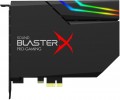Additional power
The need to connect additional power to the sound card.
Most of both internal and external (see "Type") sound cards are powered directly through the connection connector (see "Connection interface"). At the same time, for normal operation of advanced models (for example, audiophile and gaming, as well as some DACs; see "View"), this power may not be enough, which requires an additional power source. In internal audio cards, it is carried out from the computer power supply, in external ones — directly from the 230 V network.
Dynamic Range
The dynamic range of a DAC is the ratio between the loudest sound that the converter can produce and the quietest. The wider the dynamic range — the richer the sound will be, the lower the likelihood that quiet sounds that complement the overall picture will be muffled during conversion. At the same time, it is worth noting that almost all modern sound cards provide a dynamic range that is quite sufficient for comfortable everyday use, and in many models this parameter may not be indicated at all. It is worth paying attention to it when choosing an advanced specialized audio card — for example, a gaming one (see "View"). The minimum for professional models is 90 dB, but in fact, among similar solutions, this figure is usually 120 dB or more.
Max. sampling rate
The highest sampling rate that the analogue-to-digital converter (ADC) of a sound card can provide when digitizing sound. Without going into details, we can say that the role of this parameter is almost completely similar to the bit depth described in the paragraph above. And its standard values, found in modern audio cards, correspond to the following sound quality indicators:
44.1 kHz — Audio CD;
48 kHz — DVD
96 kHz — DVD-Audio 5.1
192 kHz — DVD-Audio 2.0 (two-channel audio has a higher sampling rate than multi-channel audio for a number of reasons), the highest value in modern consumer-grade sound cards.
Jack (6.35 mm)
The number of inputs in the design of the sound card using 6.35 mm Jack connectors. This connector is in many ways similar to the 3.5 mm mini-Jack described above (and is compatible with it through a simple adapter), however, due to its larger size, it is poorly suited for portable electronics. On the other hand, in the 6.35 mm standard it is easier to implement a three-channel connection scheme and ensure the transmission of a balanced signal (for more details, see "XLR"), which is often required in professional audio work. Therefore, connectors of this type are quite popular in advanced stationary technology, where connection reliability and signal quality are more important than compactness. The Jack input can be used for various purposes, which is usually indicated in the specifications; however, its very presence, usually, speaks of a rather high class sound card.
Note that on balanced XLR models (see below), a 6.35mm input can be built right into the XLR jack; in such cases, these interfaces cannot be used simultaneously.
mini-Jack (3.5 mm)
The number of outputs with
3.5 mm mini-Jack connectors in the design of the sound card. It is this connector that is used by the vast majority of modern computer headphones and speakers of all price categories (although it is relatively rare in top-end technology), and it is very popular in other consumer-class audio devices. Therefore, almost all entry-level and mid-level sound cards have at least one 3.5 mm jack; the absence of such outputs is typical for specialized models (for example, DAC, see "View"). Also note that a single mini-jack output can work with a maximum of two channels, however, this interface is also used in multi-channel sound systems — in this case, the audio card is equipped with several connectors, each of which is responsible for its own part of the system. For example, for 5.1 systems, one connector is allocated to the centre, one to a pair of front channels, one to a pair of rear channels, and one to a subwoofer.
As with 3.5mm inputs (see above), this type of output can be used in a variety of ways and can even be configurable.
Jack (6.35 mm)
The number of outputs with
6.35 mm Jack connectors provided in the design of the sound card.
This connector is in many ways similar to the 3.5 mm mini-Jack described above (and is compatible with it through a simple adapter), but due to its larger size it is poorly suited for portable electronics. On the other hand, the 6.35 mm standard gives a more reliable connection with less chance of interference on the connectors; besides, it is possible to implement a balanced connection without any special difficulties (for more details about it, see "Balanced XLR"). Both are important in professional audio work. So the presence of such a connector, usually, indicates a rather high class sound card. But the specific specifics of using the Jack type output in different models can be different, these nuances should be clarified separately.

